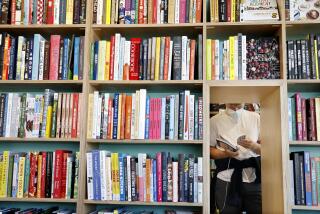Bound for Glory / One for the Books
- Share via
Book workers tend to talk a lot about skin: manipulating it and shaving it, massaging it and tanning it. “The grainier the skin, the older the calf,” says Terry Buckley, a senior lecturer at the London College of Printing. Surrounded by squares of calfskin, Buckley instructs a rapt crowd of two dozen gathered in a bland conference room at the Pasadena Hilton, where the 800-member Guild of Book Workers is holding its annual convention. This is the first year Los Angeles has played host to the guild (last year it was in, you guessed it, Tuscaloosa), and more than 150 are in attendance. They include a French woman renowned for decorative miniature bookbindings; the head of conservation at the Folger Shakespeare Library in Washington D.C., decked out in a loud tie illustrated with binders’ tools; a British widow who recently restored a colonel’s beloved volume of fairy tales; a portly binder from the Czech Republic in a work apron, and a pride of conservators from the Huntington Library.
Buckley’s demonstration is on leather staining and dyeing. “This is a teenager, basically,” he says, rubbing a calfskin with cotton saturated in spirit solution. The audience members, who have chosen his class over Exposed Binding and Album Structures, stand on their banquet chairs to better glimpse the darker hues that take over the skin. Buckley, who describes himself not as a bookbinder but as a “guardian of the text,” segues to “tree calfing”--the book worker’s equivalent of defusing a nuclear warhead. He warns that the operation might turn messy. “If I don’t want my shoes marbled, shall I move back?” asks a concerned woman with well-coiffed hair and pumps. “It’s your trousers I’m worried about,” Buckley replies.
In the vendors’ room--where blunt needles and pearl punches are laid out for sale like doctors’ instruments--the biggest crowds gather around Henk de Groot, a parchment peddler from Holland. His booth is stacked high with calf at $16 a square foot and omasum, a page-repairing material made from cow intestine that’s as thin as the peeled skin from a sunburn. De Groot sells carp skin from Siberia and salmon skin from Thailand, scaly turkey skins softer than chamois and dried-out stingrays as hard as armor. Patricia Owen, a Santa Monica architect and bookbinding hobbyist, stops to caress the delicate skin of chicken feet, too tiny to cover anything larger than a miniature book. “It’s not their fault,” says Owen, who uses minute remnants for inlays. “They’re just small.”
Dominic Riley’s hair resembles an antiquarian book--a dark and leathery color with dyed red accents for decorative effect. A 30-year-old bookbinder who came down to the two-day convention from Berkeley, Riley wears a gaping-hole-ridden green cardigan, an Antiquarian Booksellers T-shirt, green velour pants, lavender socks and no shoes. Green Day meets Gutenberg.
“Most of us probably are not in it for the love of reading,” Riley says. “It’s a craft. Historically, book workers were working-class tradesmen who didn’t read.” Riley grew up in Great Britain, where he attended a Benedictine monastery that included bookbinding as part of the curriculum. “I didn’t do sports,” he says, “so I had to do something.” Riley restores for private collectors, auction houses and libraries, fancies 18th-century texts and almost always works with calf, “the younger the better.” But he draws the lines at newborns. “I like the calves to have a little time to run around.”
More to Read
Sign up for our Book Club newsletter
Get the latest news, events and more from the Los Angeles Times Book Club, and help us get L.A. reading and talking.
You may occasionally receive promotional content from the Los Angeles Times.








